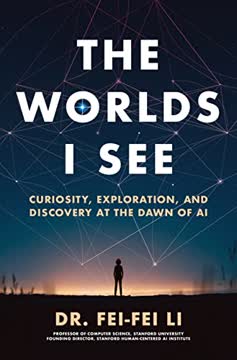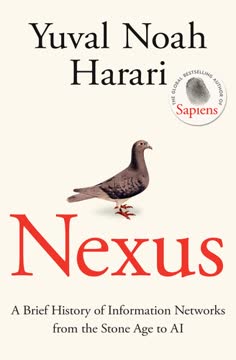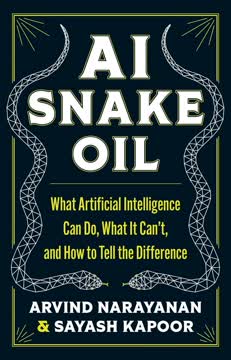Key Takeaways
1. Early AI Dreams Faced Fundamental Limits
The perceptron never lived up to the hype.
Initial excitement. Early artificial intelligence research, like Frank Rosenblatt's perceptron in the late 1950s, sparked immense hype, promising machines that could learn, see, and even be conscious. Inspired by simplified models of biological neurons (McCulloch-Pitts neurons), these early devices aimed to mimic brain function.
Simple learning. The perceptron introduced the idea of learning from data by adjusting internal weights and a bias term to find a linear boundary (hyperplane) separating data points into categories. A key theoretical result proved the perceptron could always find this boundary if the data were linearly separable.
Inherent limitations. Despite initial promise, single-layer perceptrons were mathematically proven to be incapable of solving simple non-linear problems like the XOR gate. This limitation, highlighted by Minsky and Papert in 1969, contributed significantly to the first "AI winter," halting research progress for years.
2. Mathematics Provides the Language for Machine Learning
It’s central to the plot.
Vectors as data. Machine learning fundamentally relies on representing data as mathematical objects, primarily vectors and matrices. A vector, possessing magnitude and direction, can represent anything from a person's height and weight to the pixel values of an image, allowing data points to exist in multi-dimensional spaces.
Operations reveal relationships. Linear algebra provides the tools to manipulate these data representations.
- Vector addition/subtraction: Combining or comparing data points.
- Scalar multiplication: Scaling data features.
- Dot product: Measuring similarity or projection, crucial for understanding distances and hyperplanes.
Matrices transform data. Matrices, rectangular arrays of numbers, are used to transform vectors. Multiplying a vector by a matrix can change its magnitude, direction, or even its dimensionality, forming the basis for how neural networks process information across layers.
3. Learning Algorithms Minimize Error Through Descent
When I wrote the LMS algorithm on the blackboard for the first time, somehow I just knew intuitively that this is a profound thing.
Quantifying error. Machine learning algorithms learn by minimizing the difference between their output and the desired output, often measured by a "loss function" like the mean squared error (MSE). The goal is to find the model parameters (weights, biases) that result in the lowest possible loss.
Gradient descent. Calculus provides the method to find this minimum. Gradient descent involves calculating the "gradient" (the direction of steepest increase) of the loss function with respect to the model parameters and taking small steps in the opposite direction (steepest decrease
[ERROR: Incomplete response]
Last updated:
FAQ
1. What is Why Machines Learn: The Elegant Math Behind Modern AI by Anil Ananthaswamy about?
- Comprehensive AI history: The book traces the evolution of machine learning and artificial intelligence, from early perceptrons to today’s deep neural networks and large language models.
- Mathematical foundations: It explains the elegant mathematics—linear algebra, calculus, probability, and optimization—that underpin modern AI, making complex ideas accessible to a broad audience.
- Interdisciplinary connections: Ananthaswamy highlights how concepts from biology, physics, neuroscience, and computer science converge in the development of AI.
- Societal impact: The book also discusses AI’s transformative potential, its limitations, and the importance of societal understanding and regulation.
2. Why should I read Why Machines Learn by Anil Ananthaswamy?
- Accessible math explanations: The book is praised for making the mathematics of neural networks and machine learning understandable, even for readers with limited technical backgrounds.
- Historical and scientific context: It situates technical advances within their historical and social contexts, enriching the reader’s appreciation of AI’s development.
- Bridges theory and practice: Readers gain insight into both the theoretical underpinnings and practical breakthroughs in AI, making it valuable for students, educators, and practitioners.
- Prepares for AI discourse: The book addresses open questions, ethical concerns, and societal implications, equipping readers to engage thoughtfully with ongoing AI debates.
3. What are the key takeaways from Why Machines Learn by Anil Ananthaswamy?
- Elegant math underpins AI: Core mathematical concepts like linear algebra, calculus, probability, and optimization are foundational to understanding and advancing machine learning.
- Interdisciplinary innovation: Progress in AI has often come from blending ideas across fields, such as physics-inspired neural networks and biologically motivated architectures.
- Theory lags behind practice: Despite rapid empirical advances, many mysteries remain about why deep learning works so well, including phenomena like benign overfitting and grokking.
- Ethical vigilance required: The book emphasizes the need for responsible AI development, addressing bias, fairness, and the societal impact of increasingly powerful models.
4. What are the best quotes from Why Machines Learn by Anil Ananthaswamy and what do they mean?
- “The mathematics of neural networks is elegant and accessible.” — Geoffrey Hinton, highlighting the book’s clarity in explaining complex math.
- “AI systems can inherit and amplify societal biases.” — Emphasizes the ethical responsibility in AI development and deployment.
- “Despite empirical successes, theoretical understanding of why deep networks generalize well remains incomplete.” — Points to the ongoing mysteries in deep learning research.
- “The book is a masterpiece that explains the mathematics of neural networks in an accessible way.” — Underscores the book’s value for readers at all levels.
5. How does Why Machines Learn by Anil Ananthaswamy explain the perceptron and its significance?
- Early artificial neuron: The perceptron, invented by Frank Rosenblatt, is introduced as the first algorithmic model of a brain-inspired learning device.
- Mathematical model: It computes a weighted sum of inputs plus a bias, outputting a binary classification based on a threshold.
- Foundation for neural networks: Despite its limitations (e.g., inability to solve XOR), the perceptron laid the groundwork for modern neural networks and machine learning.
- Historical context: The book details how the perceptron’s limitations led to the first “AI winter” before later breakthroughs revived the field.
6. What is the perceptron learning algorithm in Why Machines Learn and how does it work?
- Weight initialization and update: The algorithm starts with zeroed weights and updates them iteratively based on misclassified data points.
- Convergence guarantee: Mathematical proofs show that if a linear separator exists, the perceptron will find it in a finite number of steps.
- Limitations: The perceptron cannot solve problems requiring nonlinear decision boundaries, such as XOR, highlighting the need for multi-layer networks.
- Role in AI history: This limitation spurred further research, eventually leading to the development of backpropagation and deep learning.
7. How does Why Machines Learn by Anil Ananthaswamy explain the role of vectors and linear algebra in machine learning?
- Data as vectors: Data points and model weights are represented as vectors in high-dimensional space, enabling geometric interpretations of learning.
- Dot product and hyperplanes: The perceptron’s decision boundary is a hyperplane orthogonal to the weight vector, with the dot product determining classification.
- Matrix operations: Vectors are special cases of matrices, and operations like dot products and transposes are fundamental for efficient computation in machine learning.
- Dimensionality and visualization: Linear algebra tools help manage and visualize high-dimensional data, crucial for understanding model behavior.
8. What is the significance of probability and statistics in machine learning according to Why Machines Learn?
- Handling uncertainty: Probability theory is essential for reasoning about uncertainty in data and predictions, illustrated through examples like the Monty Hall problem.
- Bayesian reasoning: Bayes’s theorem is explained as a method for updating beliefs given new evidence, foundational for probabilistic classifiers.
- Estimating distributions: Machine learning models often estimate underlying probability distributions (e.g., Bernoulli, Gaussian) to make predictions.
- Parameter learning: Methods like maximum likelihood estimation (MLE) and maximum a posteriori (MAP) estimation guide how models learn from data.
9. How does Why Machines Learn by Anil Ananthaswamy describe the nearest neighbor algorithm and its challenges?
- Intuitive classification: The k-nearest neighbor (k-NN) algorithm classifies new data points based on the majority label among their closest neighbors, requiring no assumptions about data distribution.
- Historical roots: The book traces the algorithm’s origins to early theories of vision and formalizes its development through key researchers.
- Curse of dimensionality: k-NN struggles in high-dimensional spaces where distances become less meaningful, motivating the use of dimensionality reduction techniques.
- Practical simplicity: Despite its limitations, k-NN remains a powerful and easy-to-understand method for many classification tasks.
10. What is principal component analysis (PCA) and why is it important in Why Machines Learn by Anil Ananthaswamy?
- Dimensionality reduction: PCA projects high-dimensional data onto a smaller set of orthogonal axes (principal components) that capture the most variance.
- Eigenvectors and covariance: Principal components are the eigenvectors of the data’s covariance matrix, with eigenvalues indicating the variance captured.
- Managing complexity: PCA helps address the curse of dimensionality, making data analysis and visualization more tractable.
- Real-world applications: The book illustrates PCA’s use in fields like EEG data analysis and classic datasets, showing its practical value.
11. How does Why Machines Learn by Anil Ananthaswamy explain the kernel trick and support vector machines?
- Mapping to higher dimensions: The kernel trick allows algorithms to implicitly project data into higher-dimensional spaces, enabling linear separation of nonlinearly separable data.
- Computational efficiency: Kernel functions compute dot products in the original space that correspond to those in the higher-dimensional space, saving computation.
- Support vector machines (SVMs): The book details how SVMs, combined with the kernel trick, find optimal decision boundaries and revolutionized machine learning in the 1990s.
- Constrained optimization: Techniques like Lagrange multipliers are used to solve the optimization problems underlying SVMs.
12. What are the mysteries, paradoxes, and ethical concerns about deep learning and AI discussed in Why Machines Learn by Anil Ananthaswamy?
- Benign overfitting and double descent: Deep networks can generalize well even when over-parameterized, and test error can decrease again as model complexity increases, defying classical expectations.
- Grokking phenomenon: Networks can suddenly internalize deeper patterns after extended training, leading to improved generalization—a phenomenon not yet fully understood.
- Bias and fairness: AI systems can inherit and amplify societal biases, making fairness and transparency critical concerns.
- Societal impact: The book stresses the need for responsible AI development, including diverse data, transparency, and ongoing scrutiny to mitigate harms and maximize benefits.
Review Summary
Why Machines Learn offers a comprehensive exploration of machine learning's mathematical foundations, from early perceptrons to modern neural networks. Readers appreciate Ananthaswamy's clear explanations and historical context, though some find the mathematical depth challenging. The book excels in explaining pre-deep learning concepts but is lighter on recent developments. While praised for its accessibility and insights, some reviewers note it may be too technical for casual readers yet not detailed enough for experts. Overall, it's considered a valuable resource for those seeking to understand the underlying principles of AI and machine learning.
Similar Books










Download PDF
Download EPUB
.epub digital book format is ideal for reading ebooks on phones, tablets, and e-readers.




